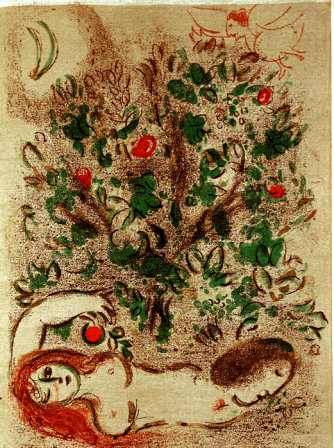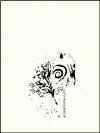
Zaidan Gallery
Home
|
Marc Chagall - (1887 - 1985) |
|
 |
|
|
Paradise - 1960 The Tree Of Knowledge — Mourlot N° 232 This is the original lithograph from Chagall's Bible Series series, as referenced in Mourlots catalogue raisonné. |
|
|
Dimensions - 370mm x 270mm - Certificate of Authentication |
|
|
|
Sales Price C$1,500 |
|
|
|
|
Paradise. Original color lithograph, 1960. 50 signed and numbered impressions plus 6500 unsigned impressions for Verve. Early commentators suggested that before the Fall, Adam and Eve were truly one flesh, separate but joined.
In this lithograph, Chagall depicted the biblical theme
of the fall of man. Adam and Eve are resting under the tree of
knowledge of good and evil. They are "one flesh" (Genesis 2,24), that
is they became one. This implies that they belong together. In Hebrew,
they are called "Adam and Adamah": Man and woman, on a par with each
other. But they rebel against God, their creator, they want to be like
him. By doing so, they put themselves in his place and this is their
real blame. In this work, Eve grabs one of the forbidden fruits which
shine nice and red. The greening tree is full of them, and just one
less won't be noticeable...? Adam is still asleep, just like he is not
"awake" when he takes the fruit from Eve and bites into it. He does
not become aware of the consequences of their doing.
In 1956, the French art critic and publisher Tériade
brought out a special issue of the legendary art magazine Verve, which
was exclusively devoted to one of Marc Chagall's major themes: The
Bible. For this outstanding issue, Chagall composed 18 full-page
colour lithographs and 12 in black and white. For his "Bible I" Marc
Chagall focused on characters from the Old Testament such as the
Founding Fathers, the Kings, the Prophets and Angels. Four years
later, in 1960, the follow-up issue "Illustrations for The Bible" was
published, with another 24 gorgeous color lithographs.
Artist's Home
"Ever since my earliest youth I have been fascinated by the Bible. I have always believed that it is the greatest source of poetry of all time...The Bible is an echo of nature, and this I have endeavored to transmit.... In art everything is possible, so long as it is based on love." Chagall
|
|
